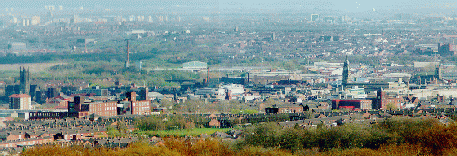Bolton
Lancashire, England

Bolton today
Bolton
Lancashire, England

Bolton today
From www.bolton.org.uk: "Bolton-le-Moors was a settlement in
a natural valley on the West Pennine Moors on the banks of the River Croal,
and the Manor of Bolton is first recorded in 1067, as being owned by the
Montgomery family. However the earliest evidence for any settlement in
Bolton goes back to the Bronze Age, with a Stone Circle in Egerton. Bolton
was part of a large area owned by the Crown after the Norman invasion in
1066. The spoils of war left it a largely barren area, but a baron of William
the Conqueror, Roger de Poictou, responsible for Liverpool and Lancaster
Castles, was given the land (between the River Ribble and River Mersey
to the west of Manchester. It was subsequently passed back to the Crown,
then on to Ranulf de Bricasard, third Earl of Chester, and transferred
to Roger de Maresy. Of the intervening families to whom this manor passed,
most held position of the Earl of Derby.

The name Bolton comes from Bolt and Tun. le-Moors is merely a description of the land which surrounds Bolton (moorland).
The town received its first Charter to hold a market in Churchgate, and annual fair, granted by King Henry III in 1251, after the Manor of Bolton was devolved by marriage. The charter reads: The King to his Archbishops, Bishops, Abbots, Earls, Barons, Knights, and to all whom it may concern greeting. Know ye that we have granted, and by this Charter confirmed, to our trusty and beloved William de Ferrars, Earl of Derby, that he and all his heirs shall have the lands and free warren in the Manors of Lyverpull, West Derby, Everton, Crosseby, Wavertree, Salford, Bowelton, Penelton, etc., in the County of Lancaster . . . . We grant to the said Earl also and to his heirs for ever, permission to hold a market at his aforesaid Manor of Bowelton, in the Country of Lancaster, every seventh day; and also at the same place a fair once a year, extending over three days, that is to say on the eve and on the day and on the morrow of the feast of St. Margaret the Virgin. The Earl of Derby, William de Ferrers granted a Charter to make Bolton a market town and borough on January 14th 1253.
Flemish weavers are recorded as arriving in Bolton about 1337 to work in the textile industry, bringing other skills including clog making. This is around the time that the industrial history of Bolton starts.
Bolton was a centre of Puritanism, and in the Civil War of the 17th Century it was a Parliamentarian outpost, surrounded by Royalist areas. Prince Rupert's army of 10,000 men were joined by troops under the leadership of the Earl of Derby, and stormed the town on May 28th 1644 from Deane Moor. This was the third major assault against Bolton, of the 3000 local troops led by Colonel Rigby, 1500 were left dead, and 700 taken prisoner. It became known as the Bolton Massacre.
After Cromwell's Parliamentarian victory, the Earl of Derby, James Stanley was hunted down and captured in Cheshire. After a three day trial, he was taken to Bolton, spent his last hours at Ye Olde Man and Scythe public house, then beheaded in Churchgate on October 15th 1651.
Prior to 1838, the area was split into "Little Bolton" with 30 trustees and "Great Bolton", who's 40 trustees were known as "The Forty Thieves". The boundary between was defined by the course of the River Croal.
On January 11th 1838 the Charter of Incorporation was drawn up by the councils of Little Bolton and Great Bolton, with the resolution "That the governing power in all communities ought to be vested in the public at large, and not in self elected bodies." A document dated October 11th 1838 was received by Mr Winder, the solicitor to the applicants on the 13th of October. The joint population was about 47000 at this time. The first election of councillors was on November 30th 1838, and Mr. Charles James Darbishire became the first Mayor. In 1838 Queen Victoria granted Bolton Chartered Borough status on the 11th of October. Neighbouring districts were embraced at the turn of the century, enlarging the town.
There was considerable distress in Bolton at this time, due to the high
cost of food brought about by the Corn Laws and other taxes, unemployment
was severe. The
Chartists, workless people who banded together to secure rights of
government, rioted in the town on August 16th 1839 and the Parish Church
was occupied
causing considerable damage. They also went on to attack the Police
Office at the former Little Bolton town hall where the mob leader was imprisoned
after his
arrest, using a lamp post as a battering ram forced entry to the building,
and further damage stopped only when a troop of Grenadiers from the 96th
Foot Regiment
arrived to disperse the rioters. Conditions continued to deteriorate,
and in 1842 Bolton was involved in the Plug Drawing Riots, bands of rioters
pulling the plugs out
of boilers causing costly and crippling damage to factory machinery.
A public fast was declared on March 12th 1847 following the failure of
the Irish potato harvest.
In the summer of 1848 an outbreak of cholera ran until the spring of
1949.

A 15th century church on this site was demolished after a closing service
on April 8th 1866, making way for the construction of this one between
1867-71, and was paid for by Peter Ormrod who was a cotton spinner living
in Halliwell Hall, at a cost of £40,000. The tower is 54 metres (180
feet) high. The new parish church was consecrated on June 29th 1871. The
earliest entry in the Register of the former church was dated January 21st
1587."

This is an Anglo Saxon Cross preserved inside
the church from the 11th century building.

The parish church at Deane